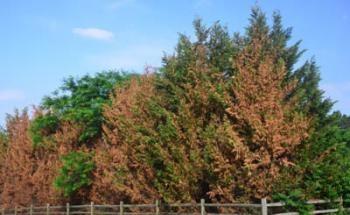Winter damage can occur on many plants. A rapid temperature drop following a mid-winter thaw can cause bark splitting. Dead twigs and branches in the spring may be the result of ice and snow damage from the winter.
Ice and snow damage
- Symptoms include bent or broken branches from the heavyweight of the ice or snow.
- Heavy snow can be gently knocked from branches, but branches that are iced over may actually be more brittle and suffer further damage if removal is attempted.
- Wind during ice storms will cause the most damage.
- White pines in our area are especially prone to winter ice and wind damage.
Winter color of evergreens

Winter damage symptoms on boxwood
- Symptoms of winter damage can include a change from the normal green color to gray, yellow, blue, purple, bluish-green, brown, and bronze leaves or needles.
- Examples of plants that are often damaged by extreme winter weather include
1) Japanese cedar (Cryptomeria) turn bronze
2) Yew (Taxus buccata) turn brown
3) Eastern red cedar (Juniperus virginiana) turn brown
4) Arborvitae (Thuja spp.) turn brown
5) Creeping juniper (Juniperus horizontalis) turn purple
6) White pines (Pinus strobus) turn yellow
7) Boxwood (Buxus spp.) turn yellow-orange
- Examples of plants that are often damaged by extreme winter weather include
- Some evergreens such as Leyland cypress and spruce usually don’t change color. Dieback in Leyland cypress can occur under extreme winter temperature fluctuations. (Read on our blog: Why Is Leyland Cypress Turning Brown?)

Severe winter damage on Leyland cypress. Photo: David L. Clement
- Causes of ‘winter color’ can include low temperatures and drought stress. Often, the foliage colors will revert back to normal when springtime temperatures return to normal.








